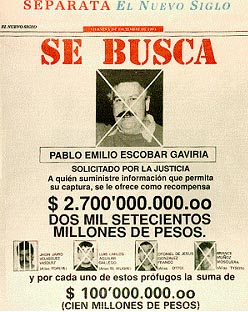Pablo Escobar
|
|
Pablo Emilio Escobar Gaviria (January 12, 1949–December 2, 1993) gained world infamy as a Colombian drug lord who became one of the richest men in the world by smuggling cocaine into the United States and countries around the world. Members of the U.S. and Colombian Governments, news reporters and the general public alike considered him to be one of the most brutally ruthless yet ambitious and powerful drug dealers in history.
Life
Escobar began what would become one of the most successful criminal careers in history as a car thief in the streets of Medellín, Colombia while still a teenager. He eventually moved into the cocaine business and began building his drug empire during the 1970s.
During the 1980s, Escobar became known internationally as his drug network gained notoriety; El Cartel de Medellín, is said to have controlled a large portion of the drugs that entered into Mexico, Puerto Rico, and the Dominican Republic with cocaine base brought mostly from Peru and Bolivia, as Colombian coca was initially of substandard quality. Escobar's product reached many other nations, mostly around the Americas, although it is said that his network reached as far as Asia.
Escobar was suspected of bribing government officials, judges and other politicians and it is said that he often personally executed uncooperative subordinates and had competitors or others he viewed as a threat assassinated. He had a strategy for persuasion that was referred to as plata o plomo; Spanish for silver or lead, intended to mean "accept a bribe or face assassination." He was the prime suspect in the killing of three presidential candidates in Colombia, as well as for the bombing of Avianca Flight 203 and a Bogotá security building in 1989. The Cartel de Medellín was involved in a deadly drug war with Colombia's other main drug cartel, Cartel De Cali.
At the height of his empire, Escobar was estimated by Forbes magazine to be the seventh richest man in the world1, with his Medellín Cartel controlling 80 percent of the world's cocaine market. Some estimates of the time placed his cartel's wealth at over $28 billion.
While an enemy of the United States and Colombian governments, Escobar was a hero to many in Medellín; he was a natural at public relations and he worked to create goodwill among Colombia's poor. A lifelong sports fan, he was credited with building little league soccer stadiums and sponsoring little league soccer teams in the city. He also bought gifts and distributed money to the poor. Much of the population worked as volunteer lookouts for Escobar and helped hide information from the authorities. Another advantage of Escobar's positive image among the poor was the ability of his cartel to use them as a recruiting pool.
In 1991, Escobar turned himself into the Colombian government in order to avoid extradition to the United States or assassination by a rival cartel. Escobar was "jailed" in his own luxuroius private prison, La Catedral, which he built himself. He negotiated an agreement with the Government of Colombia whereby he would be jailed for a mandatory five-year sentence, and he was guaranteed no extradition to the United States. However, he was often seen outside of the jail, sometimes at parties, soccer games, or other public places. After an article appeared in a local magazine showing photos of his ostentatious jail/residence and claiming that he had murdered business associates when they came to meet him at La Catedral, public opinion forced the government to act. When a government official attempted to move Escobar to another jail on July 22, 1992, he escaped, fearing that he would be extradited to the United States.
In 1992, a special police task force, known as the Search Block, was created by the Colombian government and trained by Navy SEALs and Delta Force operators to locate and capture or kill Escobar. Roughly at the same time, a secretive group known as Los Pepes (People Persecuted by Pablo Escobar), carried out a bloody retribution campaign in which more than 300 of Escobar's associates or their relatives were slain. Some observers claim that some agents of U.S. and Colombian intelligence and law enforcement organizations, in their zeal to find and punish Escobar, colluded with members of Los Pepes, mainly by sharing information and sources.
Escobar was killed on December 2, 1993, while trying to run away from the Search Block, which, using radio triangulation technology provided by U.S. agencies, found him hiding in a middle-class barrio in Medellín. Apparently a shootout between Escobar and the pursuing Search Block personnel ensued. Some claim snipers of the U.S. Command may have taken part in the final hunt for Escobar. Whether Escobar died during the actual shootout or not has always been debated, but his corpse was found on the roof of a house, together with Escobar's two personal handguns.
The hunt for Escobar was documented in Mark Bowden's book, Killing Pablo, which is being made into a motion picture.
After Escobar's death the Medellín Cartel fragmented and the cocaine market soon became dominated by the rival Cali Cartel, until the mid-1990s when its leaders too were either killed or captured.
Notes
Note 1: This list only includes individuals who are alive at the time of publication. Pablo Escobar is no longer listed in it.
Further reading
- Killing Pablo, by Mark Bowden, Penguin Books, paperback, 1992. ISBN 0142000957
- News of a Kidnapping, by Gabriel Garcia Marquez, 1997. ISBN 0375400516
de:Pablo Escobar es:Pablo Escobar fr:Pablo Escobar Gaviria zh:巴勃羅·埃斯科瓦爾

